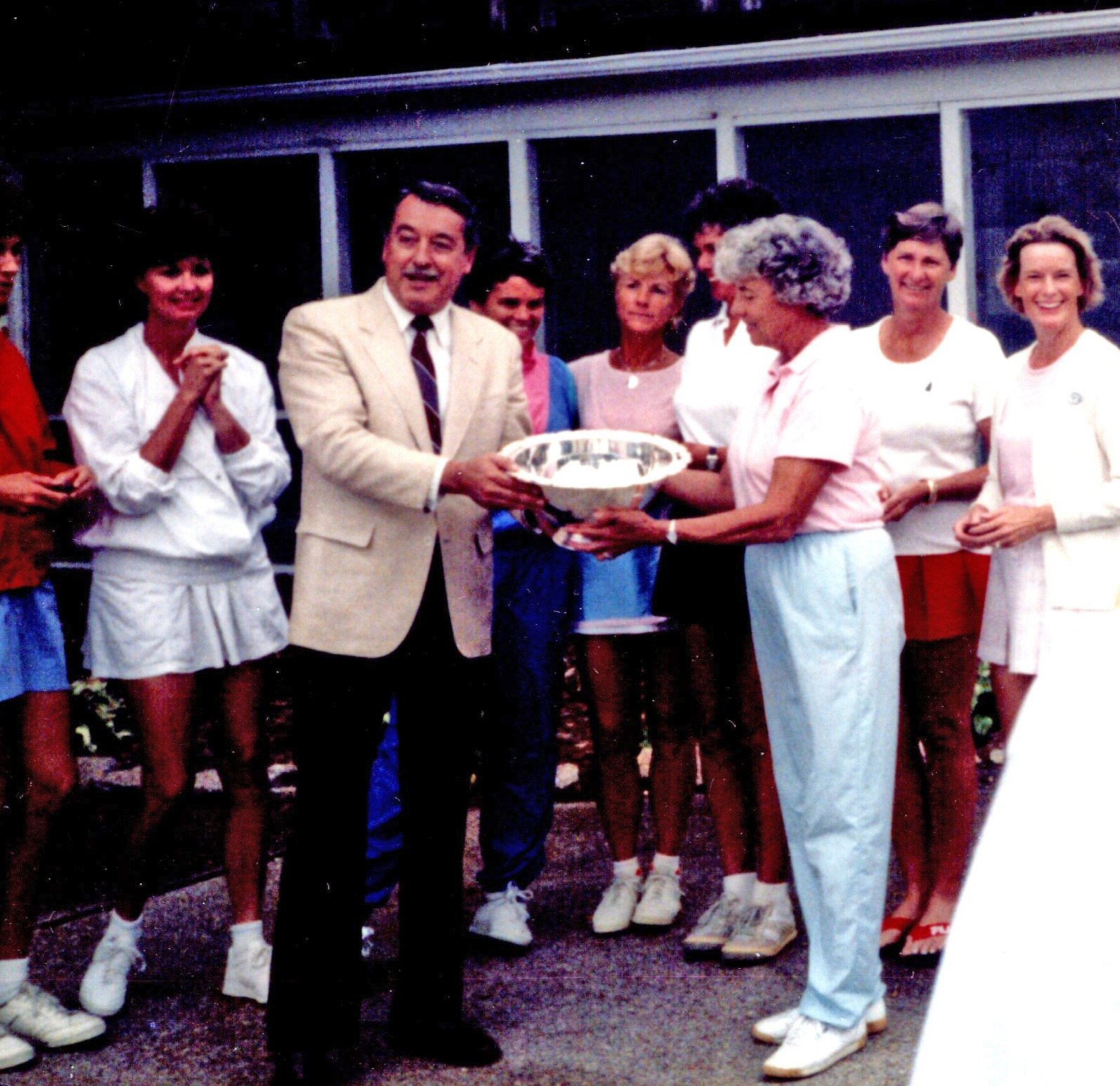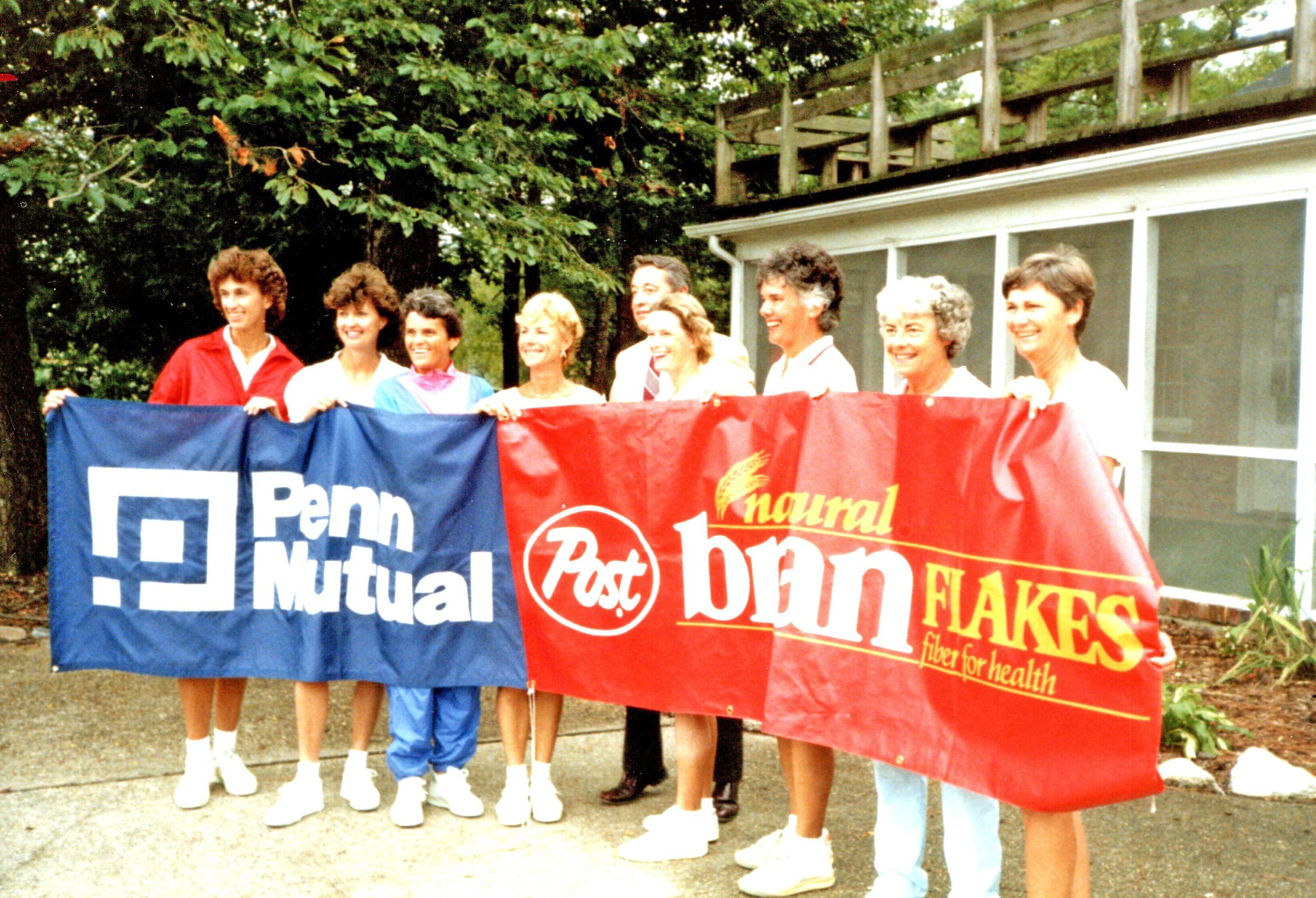USTA National Senior Women's Intersectional Team Championships
Carol Wood
It was an idea that seemed to be timely - a national team event for senior women organized by the NSWTA. Carol Wood was then the president of the NSWTA. The Pauline Betz Addie Cup, inaugurated in 1981, had become a very successful four-section team event. A national event could be just as successful and include many more players. The wheels began turning in 1985-86 and after a year of hundreds of phone calls to players, sections, sponsors, and the USTA by Carol, the event was set. The first event for the 35s and 45s took place in Virginia Beach, VA in September of 1987. The USTA provided balls from Wilson. We secured $15,000 in sponsorship - $5000 from Penn Life Insurance and $10,000 from General Foods (Post Natural Bran Flakes). 123 players showed up from 11 sections. Our entry fee per player was about $18 and because of our sponsorship, we were able to provide all the lunches, 2 dinners, and some help with hotel expenses. The usual suspects won - Florida in the 35s and Southern in the 45s.
Although the initial thought was to run only the 2 age divisions for the first several years, Fran Wakefield was anxious to put together a 55, 65, 75 event. That team championship was held in Los Angeles with 7 sections participating and an earthquake to shake things up a bit.
From the very beginning, all age divisions alternated between clay courts one year and hard courts the next. The sponsorship we had only lasted several years and the NSWTA then became the major sponsor and entry fees had to be increased. The first year in which all the ages played at the same venue was 1991 in Naples, FL, with Ellie Chartrand as tournament director. However, the next year we were separated again because we couldn't find a hard court site with enough courts. Luckily for the 35/45s, Larry Eichenbaum agreed to hold the event at Walden in Conroe TX, and in the years to follow, at Walden, Larry was able to find alternate sites so everyone could be together. All of us who have played the Intersectionals for many years know that Larry has been an integral partner both in Texas and at our clay court sites.
Beginning in 1996, USTA National provided the women's Intersectionals with significant sponsorship monies after some degree of "nagging". The USTA had been providing monies to the men's Intersectionals for several years (that event was first held in 1993 and was based on the same format as the women's). In the time frame 2004-2005, the USTA, concerned about finances, significantly reduced its sponsorship of both the men's and women's Intersectionals. The NSWTA which has always contributed to the Intersectionals has tried to provide as much funding as it can afford. Even with NSWTA funds, there has been a significant but necessary increase in the entry fees.
Here are a few additional facts that might have been forgotten or never known.
The Intersectionals were canceled in Naples in 2005 because of hurricane damage.
For 3 years, the Intersectionals included a 25s age division when the Adult Competition Committee was trying to increase tournament participation in that division.
In 2000, the 65s format was increased from 2 singles and 1 doubles to 3 singles and 2 doubles.
In 2008, an 80s division was added as a pilot (and continues as a success).
The 75s division format was 2 singles and 1 doubles until 2015 when the format changed to 2 singles and 2 doubles.
From 1987 to 1996, these championships counted for rankings but not as a "tournament played”. Beginning in 1997, the event counted on players' records as a tournament played. When the PPR ranking system began, points were awarded to each win based on position so that if the #1 player won 3 matches at position #1, she would get points equal to winning a Cat II tournament.
The Intersectionals have become the largest senior women's tennis event in the United States, with participation in the past 5 years of well over 300 players.
History of the Perpetual Trophies:
35’s
Shirley Fry Irvin donated her 1956 U.S. Open Cup to be awarded each year to the USTA Section winning the 35-and-over age division. Besides being a past U.S. Open Champion, Shirley was a former Wimbledon and U.S. Clay Court Champion. She won a number of senior women’s national titles and was an enthusiastic supporter of senior women’s tennis.
45’s
The Doris Hart Fund donated the 45-and-over team cup in memory of Sally Barnes Bondurant. Sally was a very active and popular competitor on the senior women’s circuit. She was ranked number one nationally in the 45 doubles with three different partners and her grandfather competed against Bill Tilden. She was one of the founders of Florida’s Doris Hart Cup in honor of Hart who was ranked world No. 1 in 1951 and was the fourth player, and second woman, to win a Career Grand Slam in singles.
55’s
Fran Wakefield Hunter donated this trophy because she believed the Intersectional Team Championships to be a really good thing to have for senior women’s tennis. For 40 continuous years, Fran was a USTA Circuit Chair, San Diego District Executive Board Member, USTA League Captain, Tournament Desk Coordinator, and SCTA Women’s Intersectional Organizer on all levels, where she was a pioneer in bringing about the gold, silver, and bronze ball award system to senior tennis.
65’s
The original 65’s trophy was donated by Dodo Cheney but was lost somewhere between the second and third year of Intersectionals. Betty R. Pratt donated the current trophy in 1991. Betty was a top ten player, a semi-finalist at Wimbledon and U.S. Open, and Captain of the Wightman and Federation Cups. She held many senior national titles and was a member of the winning Marble Cup.
75’s
This trophy was donated by Jacqueline Piatigorsky, a player who took up the game at the age of 42. Her first tournament was with her son, and she won many national doubles titles, illustrating that tennis is truly a lifetime sport.
80’s
Mary Lenore Blair, a past president of the National Senior Women’s Tennis Association, now the National Women’s Tennis Organization, donated this cup. Mary won many USTA National Championships.
Photo Gallery












